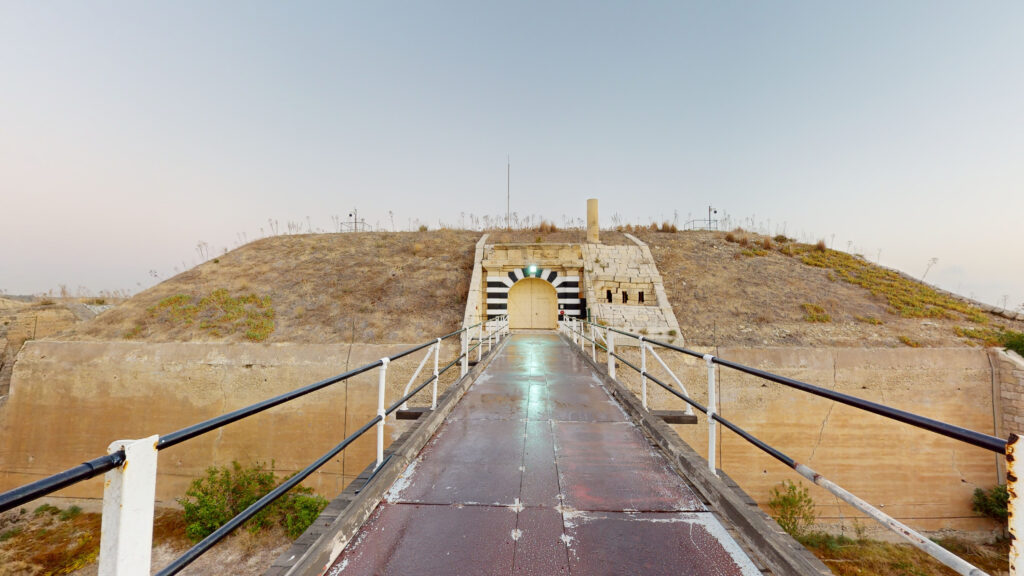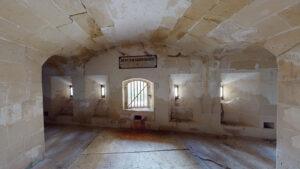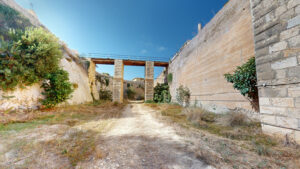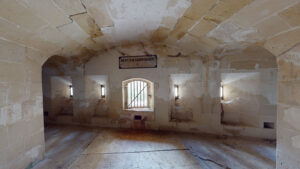
WELCOME!
to
Fort Mosta

Occupying a central position along the escarpment of the Great Fault, Fort Mosta was the most strategically-placed land fort on the system of inland defences known collectively as the Victoria Lines. The Fort’s designation as a ‘land fort’, its strategic location roughly in the centre of the North-West front (later renamed the Victoria Lines), and the topography of the site on which it was built, were all to dictate both its structural shape and form and its defensive role (and, hence the nature of its armaments with which it was to be equipped).
 Today, this important example of late nineteenth-century British military architecture is currently used by the Armed Forces of Malta as a storage depot. It state of preservation, despite the Army’s many effort to keep it in good condition, is such that it requires, and deserves, specialized attention and interventions to counter the damage that is being inflicted to the structure as a result of the particular geological conditions of the site. Furthermore, a military architecture entity of such calibre, effectively a strategic nodal point in the extensive system of fortification known as the Victoria Lines, deserves to be integrated more productively into the broader cultural and tourism sectors for the greater common good.
Today, this important example of late nineteenth-century British military architecture is currently used by the Armed Forces of Malta as a storage depot. It state of preservation, despite the Army’s many effort to keep it in good condition, is such that it requires, and deserves, specialized attention and interventions to counter the damage that is being inflicted to the structure as a result of the particular geological conditions of the site. Furthermore, a military architecture entity of such calibre, effectively a strategic nodal point in the extensive system of fortification known as the Victoria Lines, deserves to be integrated more productively into the broader cultural and tourism sectors for the greater common good.
Fort Mosta was originally designed as one of three isolated strongholds on the North-West Front. This was a defensive position adopted by the British military and intended to divide Malta into two parts, concentrating the fortified assets along the line of a natural fault cutting across the width of the island – for more information go to our article. Fort Mosta’s construction was approved in I873, but, in actual fact, the first of these strongholds to be initiated was Fort Bingemma, begun in I875. This was then followed by Fort Madalena in I878, and by the time of General Lintorn Simmons’ visit to Malta in February I878, work on Fort Mosta had not yet commenced.
Simmons visit, however, seems to have put the wheels in motion for the construction of the structure was commenced some time after. The new work of fortification, designed as a hill fort, came to consist of two main component parts – a casemated keep of pentagonal plan, surrounded by a defended ditch, and an external battery. Owing to the fact that no initial, or even period, record plans of the fort have survived, it is difficult for historians of British military architecture in Malta to determine the configuration of the original design, particularly where it involved the annexed battery. The present structure provides various hints of an incremental development. The addition of two disappearing gun emplacements in the 1890s, for example, would have witnessed the replacement of earlier barbette emplacements (as is known, and documented, to have happened at Fort Bingemma).
the wheels in motion for the construction of the structure was commenced some time after. The new work of fortification, designed as a hill fort, came to consist of two main component parts – a casemated keep of pentagonal plan, surrounded by a defended ditch, and an external battery. Owing to the fact that no initial, or even period, record plans of the fort have survived, it is difficult for historians of British military architecture in Malta to determine the configuration of the original design, particularly where it involved the annexed battery. The present structure provides various hints of an incremental development. The addition of two disappearing gun emplacements in the 1890s, for example, would have witnessed the replacement of earlier barbette emplacements (as is known, and documented, to have happened at Fort Bingemma).
The Forts of Malta

The forts of Malta constitute a remarkable historical legacy. These fortifications are scattered across the islands, reflecting centuries of strategic importance. Notable among them is the grandeur of Valletta, a fortified city constructed by the Knights of St. John in the 16th century, exemplifying the Renaissance military architecture. The fortifications of Valletta include Fort St. Elmo and Fort St. Angelo, which played pivotal roles in the defense of the island during the Great Siege of 1565.
Throughout Malta, one can discover a network of coastal watchtowers, such as the Wignacourt Towers, built to safeguard against pirate raids. The British era introduced forts like Fort Rinella, featuring a colossal Armstrong gun.
These forts and fortifications bear witness to Malta’s tumultuous history, from Arab rule to British colonialism, and they have earned UNESCO World Heritage status. They continue to captivate visitors, offering a tangible connection to the island’s past and the enduring importance of strategic defense in its history.